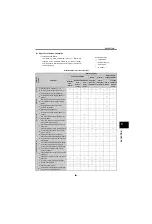
506
SELECTION
3.4.2
Improvement of power factor
A widespread method of improving the power factor is to
insert a reactor in the AC or DC side of the converter in
order to smooth the current. (The inverter input power
factor is not improved if a power-factor improving power
capacitor is inserted in the input circuit. A capacitor must
not be inserted in the output circuit. If inserted, the
capacitor will be damaged by the harmonic current of the
inverter.)
By connecting the optional FR-HAL or FR-HEL power-
factor improving reactor to the inverter, the current
waveform is improved and the power factor improved as
shown in Fig. (b). In addition, the effective value of the
input current is reduced.
Use of the high power factor converter (FR-HC) will
improve the input current waveform to a sine-waveform,
improving the power factor to almost 1 (when the load is
100%).
The inverter input current is influenced by the reactance of
the power supply line and that of the input transformer.
When the reactance of the line is large, the power factor is
higher and the input current is smaller. When the input
power factor is higher when the power factor improving
reactor is installed, the input current may be smaller than
the output current.
3.4.3
Inrush current
In a PWM inverter which comprises of a capacitor-input
filter circuit, an inrush current flows into the large capacity
smoothing electrolytic capacitor when the input MCCB is
switched ON. This inrush current, which flows only for the
capacitor charging time, is extremely large despite its short
duration. Since the inrush current is inversely proportional
to the impedance of the power supply, the inrush current
increases in proportion to the rise in power supply capacity.
To suppress the inrush current, an inrush current
suppressing resistor of short-duration rating is provided in
the converter circuit of the all models.
Avoid switching the inverter power supply ON/OFF
frequently. The inrush current occurring frequently at
power-ON may deteriorate or short the inrush current
suppressing circuit or damage the rectifier circuit, for
example.
Especially when the power supply capacity is large, use
the optional power factor improving reactor (FR-HAL) in
accordance with the selection conditions.
3.4.4
Instantaneous power failure
In
, if an instantaneous power failure has
occurred (15ms or longer), the inverter protective circuit is
activated to coast the motor to a stop.(Refer to page 34)
When the power is restored in less than about 50 to
100ms, the instantaneous power failure protective circuit is
kept activated and the motor does not restart. When the
instantaneous power failure time is approximately 100ms
or longer, the inverter is initial-reset at the time of power
restoration and the inverter restarts if the start signal
remains ON.
do not have protection against
instantaneous power failure. Inverter output is shutoff when
the bus voltage falls below the specified value. If the start
signal has been ON when power restores, inverter restarts.
If the motor is coasting at this time, a large current may
flow in the inverter and activate the current limit function. In
this case, the motor is suddenly decelerated, then
reaccelerated. To ensure smooth restart of the coasting
motor at the time of power restoration, use the automatic
restart function after instantaneous power failure.
Use power-failure deceleration stop function to stop the
motor at occurrence of a power failure for fail-safe of
machine tool, etc.
Use operation continuation function at instantaneous
power failure to continue operation without the motor
coasting even if an instantaneous power failure occurs
during operation.
Voltage
Current
(a) Without power-factor improving reactor
Voltage
Current
(b) With power-factor improving AC reactor
Voltage
Current
(c) When high power factor converter is used
Inverter input current waveforms
A700
F700
E700
D700
Summary of Contents for FR-A700 Series
Page 245: ...279 2 PARAMETER PARAMETER MEMO ...
Page 440: ...474 PARAMETER MEMO ...
Page 522: ...556 SELECTION MEMO ...






























